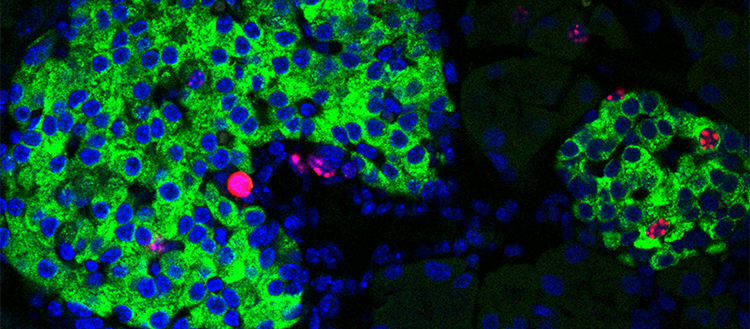Lipids and diabetes are closely linked
By analysing the lipid profiles of dozens of people, UNIGE and HUG scientists have highlighted the importance of fat in the detection and treatment of type 2 diabetes.

Image of pancreatic islets with insulin-producing beta cells (green). © UNIGE / Dibner
While sugar is the most frequently named culprit in the development of type 2 diabetes, a better understanding of the role of fats is also essential. By analysing the blood profiles of dozens of people suffering from diabetes or pre-diabetes, or who have had their pancreas partially removed, researchers at the University of Geneva (UNIGE) and Geneva University Hospitals (HUG) have made two major discoveries. Firstly, the lipid composition of blood and adipose tissues fluctuates during the day, and is altered in a day-time dependent manner in diabetics, who have higher levels of toxic lipids. In addition, one type of lipid, lysoPI, is capable of boosting insulin secretion when the beta cells that normally produce it fail. These results, published in the journals Cell Reports Medicine and Diabetes, may have important implications for the treatment of diabetic patients.
The role of lipids in the physiological and pathological processes of human metabolism is gradually becoming clearer, particularly in type 2 diabetes, one of the most widespread serious metabolic disorders. Thanks to cutting-edge tools, in particular mass spectrometry, researchers are now able to simultaneously measure the levels of several hundred different types of lipids, each with its own specific characteristics and beneficial or harmful effects on our metabolism.
‘‘Identifying which lipids are most present in type 2 diabetics could provide a basis for a wide range of interventions: early detection, prevention, potential therapeutic targets or personalised recommendations — the possibilities are immense,’’ indicates Charna Dibner, a professor in the Department of Surgery, and Pierre Maechler, a professor in the Department of Cell Physiology and Metabolism, at the UNIGE Faculty of Medicine, and members of the Diabetes Faculty Centre, who led these studies. ‘‘This is why we carried out a detailed analysis of the blood profiles of patients recruited in four European countries and confirmed some of our results on a mouse model of the disease.’’
Chronobiology to better identify diabetes
The team led by Professor Charna Dibner, a specialist in circadian rhythms in metabolic disorders, carried out a ‘‘lipidomic’’ analysis of two groups of patients in order to establish the profile, over a 24-hour cycle, of multiple lipids present in the blood and adipose tissues. ‘‘The differences between the lipid profiles of type 2 diabetics and people without diabetes are particularly pronounced in the early morning, when there is an increase in certain toxic lipids,’’ explains the researcher. ‘‘Why? We don’t know yet. But this could be a marker of the severity of diabetes and paves the way for personalised care according to each patient’s specific chronotype.”
And implications go beyond diabetes: if samples are taken at very different times of the day, the results can be distorted and give contradictory results. ‘‘It’s the same thing in the clinic: an examination carried out in the morning or evening, or a treatment taken at different times, can have an impact on diagnosis and even on the effectiveness of treatments.’’
A crutch for beta cells
Charna Dibner and Pierre Maechler extended their lipidomic analyses to include not only people with type 2 diabetes but also a mouse model of pre-diabetes and patients who had lost around half their insulin-producing beta cells after a surgery. ‘‘We discovered that a type of lipid, lysoPIs, increases when there is a sharp decrease in functional β cells, even before the onset of clinical symptoms of diabetes.’’
The scientists then administered lysoPI to diabetic mice and observed an increase in insulin production. ‘‘The same phenomenon occurred in vitro, on pancreatic cells from diabetic patients,’’ adds Pierre Maechler. ‘‘The lysoPIs therefore have the capacity to reinforce insulin secretion by acting as a crutch when the number of beta cells decreases or when these cells malfunction. Yet, certain foods, such as legumes, naturally contain lysoPI precursors.’’
By bringing to light the unsuspected role of lysoPIs, researchers will be able to explore new avenues opened by their discoveries. The development of dietary supplements or even molecules specific to lysoPI receptors could be an interesting strategy for controlling diabetes, as could taking better account of the chronobiological profiles of patients. Diabetes is a complex disease that calls for much more personalised management than is currently the case.
